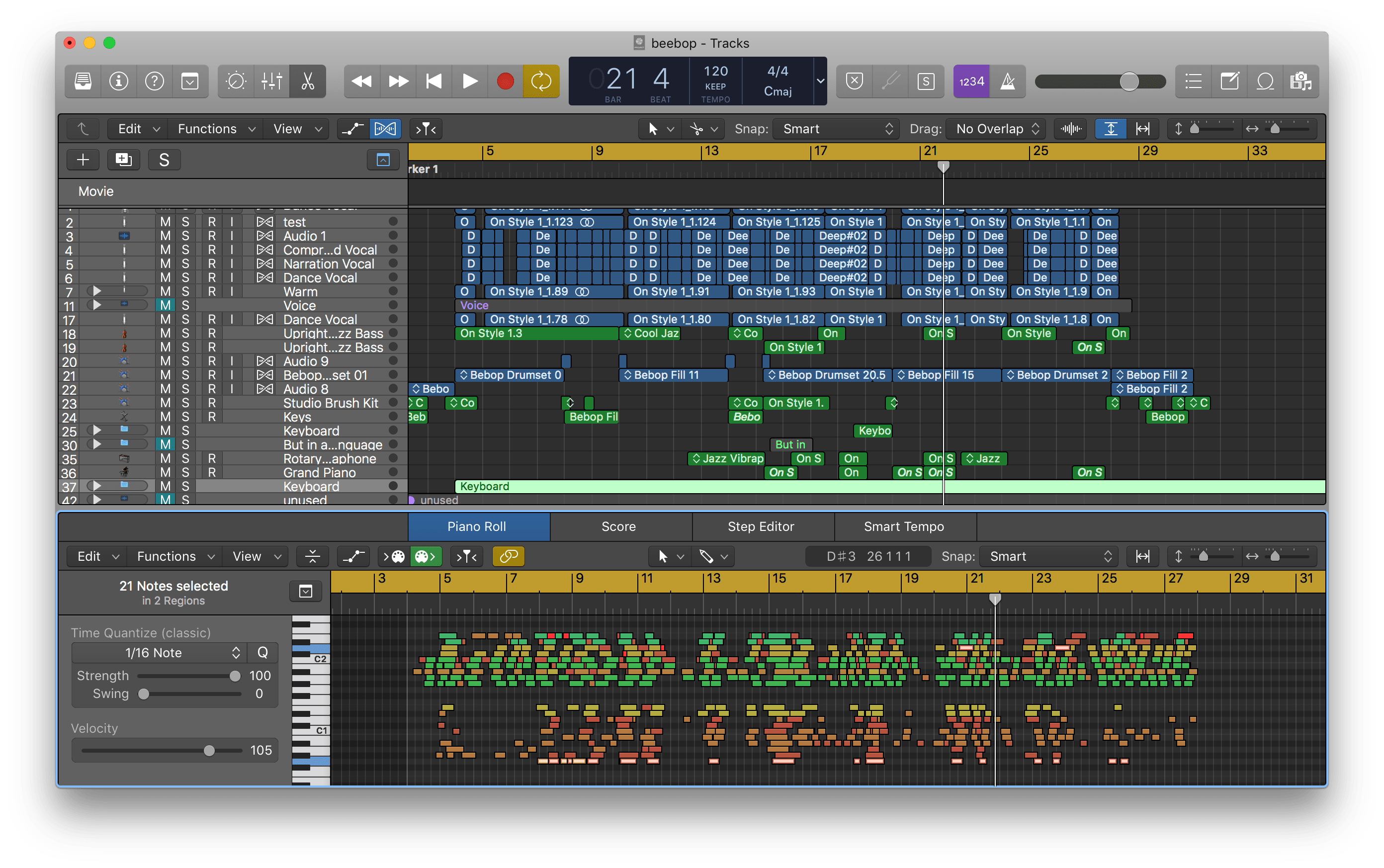We make music when we speak. When we write, the music is in our head, and typing we play the drums. Being fully immersed in writing is like composing and playing music while we drum up our perceptions into letters, words, sentences, and paragraphs. How does it all play together?
Music in Spoken language
In spoken language, music and meaning are directly related. We get louder when we are angry or excited, we inflect the important words in a sentence. Questions are as much defined by their syntax as they are by their melody. You can ask a question by simply singing an affirmative sentence. But if you sing every statement like a question you are stretching it. You cannot overstretch contradiction in tone and meaning without stressing us out.
Meaning and music are interdependent. Melody emphasizes meaning and, at the same time, the musical pattern it shapes predefines what we say next. Our mind follows grammar and logic as we try to express our feelings, while our body follows and creates pitch, rhythm, and melody.
When we speak, we both perform and follow a musical pattern. Stuttering, stopping and repeating ourselves as we correct mistakes we interrupt the musical flow, but fundamentally we need to follow a rhythm, melody, and a certain pace to move forward. We simultaneously express what we feel and begin to hear in our head as we move our lips. The time we have for composition and performance is limited by the attention span of the person we talk to.
Music in Written Language
Good writing sounds natural, in other words, like spoken language. To check if your writing works, speak it out loud. If you stumble doing so, you know where to improve.
Writing, we have more time to find words, stop and correct ourselves than when we speak. The rhythm and melody of the preceding sentences don’t guide us as strictly. This gives us more freedom, but it can lead to an unnatural choice of words and, in consequence, to an artificial awkward tone.
Music in Typing
As we write on a keyboard, and we compose a melody in our minds, we inadvertently perform a spontaneous percussion that, again, shapes our writing and its own continuation. While we begin, continue and finish a period melodically in our heads, we go with the rhythm of our typing when we can. We compose music as we find words and we play percussion as we type. Rammadamm-pa-daradamm-pa-ratttatttattadaradamm!
If you are experienced with writing on a mechanical typewriter you know that it’s as much a drum as it is a writing tool. If you write a lot on a keyboard device, I imagine that you are nodding by now.
When we write, the music we find as we are looking for words plays in our heads. We hear it with our inner ear. As we act on it, the jolting percussion we drum out on the keyboard. If you write a lot, you notice the keyboard percussion itself can impact your writing. Typing turns into drumming and it makes us move forward. If you type baddabing, you want close it with a badaboom. If you are in the zone, the music in your head is influenced by the percussion of your fingers tapping. We write better if, as we focus on the words in our head, we follow the drum that we play as we type. And when everything comes together, when the music in our head and the percussions through our fingers come together, we flow.
Writing, Style and Music: A Practical Example
Asked how to avoid clichés, Martin Amis pointed out the complex relationship between writing and music.
His answer in itself is a demonstration of style through music:
Style. You don’t take an ordinary paragraph, your decorative paragraph, and then give it style, and lots of rumble and wow, you know, and fuzzbox. You don’t do it that way. What you’re trying to do is: Be faithful to your perceptions, and transmit them as faithfully as you can. But in a language… In a… that… You know I just say these sentences again and again in my head, until they sound right. And there is no objective reason why they sound right. They just sound right to me. So it’s euphony, sometimes it’s harshness you want. But it’s… it’s just matching up the perception with the words… in a kind of semi-musical way. Even if it’s atonal.
Listening closely to the interview, you may notice that Amis himself searches for and follows a distinguishable melody as he speaks.
Voice Only
Here is the voice track isolated. Focus on the music instead of the meaning. Can you hear the melody, pitch, rhythm? If you do, move to the next track.
Bass Transposition
If you transpose melody, pitch, and rhythm of Martin Amis’ riff into a Jazz bass line this is more or less how it would sound:
Voice and Bass Transposition, mixed
Now, for comparison, voice and bass transposition mixed together:
Sounds almost like a real Jazz track, doesn’t it? What is missing here, is a nice drum track. What if we mix it with the sounds we’d hear if this were typed? We’ll get to that in a moment. Let’s first listen to how beautifully Amis closes his étude.
Be faithful to your perceptions
Martin Amis demonstrates, speaking, how writing with style works. He points out that being “faithful to your perceptions” is where you start. A writer perceives carefully and stays true to these perceptions. Clichés are not perceived, they are not felt. They are patterns, repeated mindlessly. Some of your perceptions may not meet the listener’s expectations. And it is exactly those perceptions that do not meet the common expectations that may be worth talking about. Staying faithful to them means you cannot make up special perceptions just to be extraordinary.
Being “faithful to your perceptions” means you “transmit them as faithfully as” you can. Beginners sometimes assume writing is mostly about the act of transmission of information from the sender to the receiver. And this is how they tend to fill their transmissions with “lots of rumble and wow” to impress their readers. As you get more experienced with writing, you learn this is profoundly wrong. Writing is making someone else feel what you feel. There are two transmissions. Language is the means of transmission:
- The transmission of your perceptions into language
- The transmission from your perceptions encoded in that language into someone else’s perception
The way to faithfully express yourself is in itself an act of finding the right tone. When he says:
But in a language… In a… that… You know I just say these sentences again and again in my head, until they sound right.
Martin Amis demonstrates right there how it works. It’s as if we saw him typing and deleting.
Martin Amis tries different openings, firing at a fast pace before closing with: “I just say these sentences again and again until they sound right”. Here, again, he describes what he is doing as he is doing it. He rephrases his perception until he finds a faithful transmission into words.
The Music in Typing
If you transpose Amis speech into the sound he’d make if he were typing his words, you’d get a fast, chaotic drum track. To better illustrate, we used the sounds of a 1984 Macintosh keyboard. Contemporary keyboards are more silent.
With a bit of imagination, you may hear the characteristics of a Flamenco Gitano, but it sounds more like rain than music. The fast-paced keyboard sound and the extracted bass don’t mix all too well as they describe the same track. And it doesn’t sound like when we type. The keyboard track is too fast. And when we type, music and drums are not completely in synch. We keep repeating the syllables in our heads, and when we type we repeat them slowly.
Apart from that, the typing sounds unnatural as it is way too fast. Martin Amis is not just an artful speaker. He is a very fast speaker, too. Most of us not only write less artfully than Amis speaks, we think, speak and type slower. If we play the keyboard track a bit slower, we re-find a somewhat familiar drum track. It’s the track we all more or less inadvertently play as we type:
The melody and pitch of the music we compose as we write in our heads. At the same time, pace and rhythm are influenced by the percussion as we type. All of that happens at a slower speed than reading.
For most writers, the process of repeating “sentences again and again in [our] head until it sounds right” takes longer than for Amis when he speaks. We take pauses, where we think, we repeat words until they sound right, and then, as we type we taste or repeat those words again and again until they fit together. It’s rarely a clean cut think-write-think-write process. It’s an a-linear mix and remix of thinking, rethinking, typing, and correcting. The keyboard track and the musicality of the voice differ more from outside than from inside.
Writing is right when the words “just sound right”. How do we know if they sound right? We just know. Amis says laconically:
…there is no objective reason why they sound right. They just sound right to me.
There is a lot of harmony and melody packed in “they just sound right to me”. Style can be explained, but it cannot be calculated.
There’s music in math and math in music and computers can imitate Bach and Beethoven, but it’s not music until a human feels what has been felt by another human. Just something being felt by the listener is not what music is about. The magic in music happens when you feel that you understand another person through music.1
Amis puts it like this: The challenge of good writing is to match “your perception with the words.” That can turn out in a well or harsh sounding result. Language is not fully musical, it’s “semi-musical” and, often a-tonal.
Sound and Vision
There is a third element joining typing and the music in your head. The letters shaping into a text on the screen. It’s difficult to illustrate the writing experience as the inner experience while writing doesn’t match the sound and the letters you experience watching someone writing. Putting all three together, ideally, you feel something like this:
Martin Amis points out that writing is semi-musical. It’s not fully musical, but it is more musical in our heads than it looks from outside. How can we illustrate that?
From Semi-Musical to Fully Musical
To make it work as a musical piece it needed more recognizable patterns, repetition, and modulation. We chose to make a bebop track that matches the fast speed and pitch of Amis speaking style. We adjusted the transposed bass track into a walking bass singling out some typical sequences. Then and evened out the keyboard sounds into more musical drum sequences. If you listen closely you can hear initially how the typing turns into the drum track. We pick up the keyboard clicking here and there. It took a couple of weeks to make it sound like a real jazz track.

The article was written in the spirit of bringing together design and philosophy. It required that I get familiar with music theory and making music, which were both completely new to me. Putting together music making and aesthetic thinking was easier and more pleasant than I thought, but I am aware that this is all done at a highly amateurish level. If you are more experienced, you will hear deficiencies. Of course, I am more than happy to take your feedback and tips to improve. If you learned from it and you enjoyed the experiments only half as much as I did, I achieved more than I could have hoped for.
- Unless you’re a fan of Schönberg, a man that reportedly never laughed in his life, to those who listen to music for the experience it matters that those who compose felt what they compose. Just as it matters to most of us that writers meant what they said. ↩








